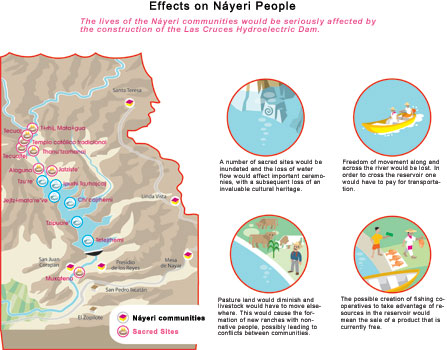Las Cruces Dam threatens agriculture and fisheries
TEPIC
With the construction of the Las Cruces dam on the Rio San Pedro Mezquital, the 617 foot spillway would retain 90% of the sediments and nutrients that have fertilized the land downstream under cultivation and given life to the coastal lagoons of the National Wetlands, and would result in severe impacts on agricultural and fishing activities, warned NGOs on February 14.
The environmental impact statement (EIS) presented by the Federal Electricity Commission (CFE), reveals "the artificial flow regimen would eliminate or diminish the quantity of intermittent runoff in downstream areas, creating an imbalance in the processes of sediment transport and soil replenishment, as well as in the interconnection between areas of seasonal accumulation."
Chapter 5, page 80 notes that "this impact is related to the decrease in the fertility of soils and of the lagoon system through modification of nutrients and organic material."
Around 10,000 agriculturalists depend on the seasonal inundations of the Río San Pedro, and their annual production has been valued at more than US$79.4 million.
Chapter 5, page 74 of the EIS discusses the impacts on the coastal zone, pointing out that according to the CFE’s study "the biological productivity of marine waters will be most affected by changes in planktonic composition, which in turn will strongly impact the species dependent on the plankton. Included are species of great commercial importance for both the region's and the nation’s economy."
Fishing and oyster farming in Nayarit supports more than 2,000 fishing families and generates goods valued at more than US$11.9 million annually.
The negative effects will be felt throughout the Gulf of California, since the wetlands in Nayarit are the principal breeding grounds of shrimp, points out project opponents.
Currently the Secretariat of the Environment and Natural Resources (Semarnat) is evaluating the CFE's EIS in order to decide if it will authorize or reject the project.
Rural organizations, ejidos, and fishing cooperatives have publicly protested the dam.
They believe the dam is unwarranted based on the EIR findings. The plant would be non-operational for 66% of the time, the turbines shut down for more than 20 hours per day during 8 months of the year. It would generate less than 1% of the energy demand for the central-west region, and would hold back 90% of the sediments that the San Pedro Mezquital River provides, eliminating needed nutrients for commercially important species both in the agricultural valley and in the coastal lagoons of the National Wetlands Biosphere Reserve.
The disappearance of the seasonal inundations of the river and the nutrients that it carries to the valleys and the coastal lagoons would cause high impact on farming, livestock, fishing and tourist activities, that annually benefit directly around 10,000 producers with US$23.6 million, according to the World Wildlife Fund and the Gonzalo Rio Aronte IAP Foundation of Mexico.
If the useful life of the dam is 50 years, it would stand idle approximately 33 of those years. However, it would cost US$618.3 million according to leaders of the NGOs Sumar, AIDA, Nuiwari, the Náyeri Council, and the community Council of the Río San Pedro.
This amount is equivalent to the budget for Tepic for 8 years.
The other four months, from July to October, the turbines would function between 18 and 21 hrs per day, generating 778 gigawatts, or just 0.9% of the energy demand projected by 2026 for the west-central region.
Of the 9 states that comprise this region, Jalisco is first in demand, with 24.9% of the electricity sales, while Nayarit is in last place with only 2.8%.
From the beginning of the exploratory studies for the hydroelectric project, the CFE has systematically violated the rights of the zone's indigenous towns, says the NGOs. Although the EIR admits that some of the most important sacred sites and ceremonial centers would disappear, such as at Muxatena,the NGOs complain that the people have not been consulted.
For the Nayeri, Wixarrika, Tepehuano, and Mexicanero towns, the Río San Pedro is part of their territory, a basic part of their spiritual life and the center of their traditions and cultural identity.
The Río San Pedro Mezquital is the last remaining river without dams or hydroelectric plants in Northwest Mexico, the seventh largest river in the country, the source of sustenance for communities in central Nayarit, and the principal source of drinking water in southern Durango state.


